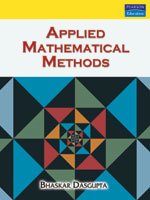Applied Mathematical Methods
- Bhaskar Dasgupta
For Teachers
The author thinks that the ideal method to use this book for instruction in a course involves the following aspects.- The last piece of advice is perhaps the most important. You may like to read that first.
- Match the contents of the book with your intended syllabus. Decide on topics that is must for your course, but are absent in the book. (Sorry for the omission.) Make lecture-size insertions at appropriate locations. Among the existing chapters (supposed to be lectures), decide on adding and removing asterisks, in the sense of exclusion and inclusion for your course.
- Now, compare the total number of lectures against the available number of lecture hours. Fine tune and consolidate the course plan. Plan the grading scheme.
- To the extent possible, execute lectures in the current order. Try to keep the leture boundaries same as the boundaries of chapters and your inserted modules.
- For a chapter somewhat larger than a lecture hour, it is better to leave a section with a brief outline, instructing the students to read up the matter, rather than breaking the modularity into a continuous chain of talk across lectures.
- At times, you may decide to break a chapter into two lectures and end up with a free 20-25 minutes out of the second lecture hour. Do not embark on the next chapter. Invite general questions and discuss. May be, take a quiz.
- One of the tricky issues of classroom instruction is
the use of slides. If you do not like their use and prefer
to stick to the board-work, then I am your friend. 'Development'
of ideas and arguments in the class is perhaps the main value
of the classroom. However, the professor writing down huge
dummy matrices or 10-line algorithms for the purpose of reference
is sometimes boring and unfocussing! So, I sometimes resort
to a combination of slides
and board-work. If you too plan to follow a similar strategy,
you may like to consult or try out
my set of slides. - Ask the students to read up a chapter before the lecture in which it is going to be covered. Encourage them to attempt all exercises of the covered chapter, if possible. But, do release the short selection list for those students who might find the complete exercises too challenging in terms of speed and maturity.
- If your course has a provision for tutorial sessions, then finalize the tutorial problems for every such session and have a discussion with the tutors. You can find one such set of tutorial problems in my own tutorial plan, which includes mostly non-trivial and/or conceptually rich exercises in which majority of students may need some guidance. Note that students are likely to be receptive to these tutorial problems mostly 'after' they have attempted some exercises in the corresponding chapters on their own.
- The appendix contains enough information in the way of
solution outline. Still, there may be occasions when an
instructor may feel the need of looking at the author's full
step-by-step solution, possibly for verification and conflict
resolution. In such cases, an instructor is requested to
write to the author. However, response to every such query
would need non-trivial effort on the part of the author.
Besides, a point is made to share such a piece of information
with teachers only. Therefore,
- the query/requisition should be limited, pointed and non-trivial, and
- the antecedents of the person making the query should be clearly stated.
- At the end of the course and before the final examination, explore the possibility of compiling a set of quiz questions and conduct an oral quiz of duration 3-4 hours, with a break in between. It actually works, it gives a thorough revision just at the right time and it is a lot of fun.
- While planning and executing your course, if you keep forgetting these pieces of advice from this colleague, then perhaps you have hit upon your own favourite strategy. That may be the best strategy to stick to.
